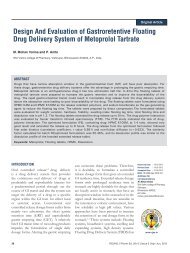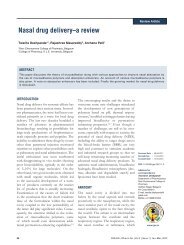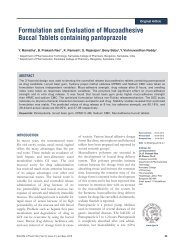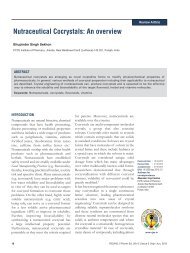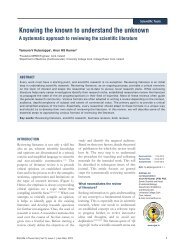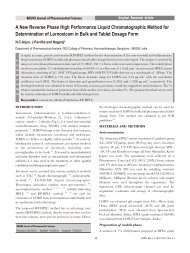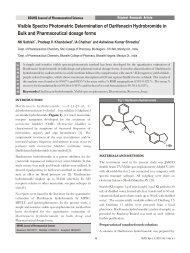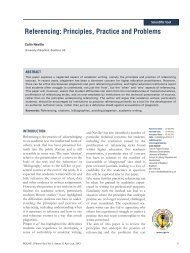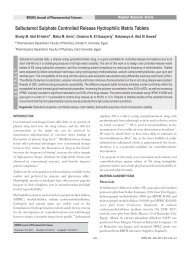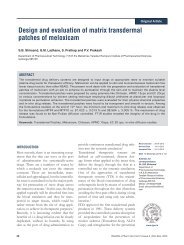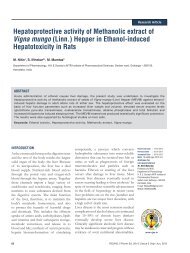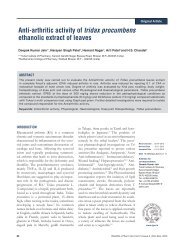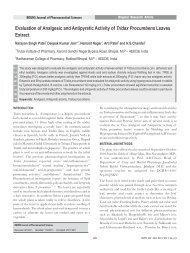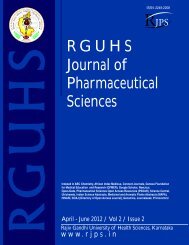Chitosan Loaded Mucoadhesive Microspheres of Gliclazide - Journal
Chitosan Loaded Mucoadhesive Microspheres of Gliclazide - Journal
Chitosan Loaded Mucoadhesive Microspheres of Gliclazide - Journal
You also want an ePaper? Increase the reach of your titles
YUMPU automatically turns print PDFs into web optimized ePapers that Google loves.
physiological saline. The solution was administered orally<br />
(p.o.) in a volume <strong>of</strong> 1 ml/100 gm <strong>of</strong> animals using a bulbed<br />
steel needle.<br />
7<br />
Phytochemical Screening<br />
Preliminary phytochemical screening <strong>of</strong> the ethanolic extract<br />
<strong>of</strong> leaves was performed for the presence <strong>of</strong> alkaloids,<br />
phenolics, flavonoids, saponins, carotenoids, carbohydrates<br />
and glycosides.<br />
AnimalsUsed<br />
Albino wistar rats <strong>of</strong> either sex weighing between 150 to 200<br />
gm and albino mice <strong>of</strong> either sex weighing between 20 to 25<br />
gms were procured from registered breeders (346/CPCSEA,<br />
Mahavir Enterprises, Hyderabad.) used for studying antidiarrhoeal<br />
activity and acute toxicity respectively.. The<br />
animals were housed under standard conditions <strong>of</strong><br />
temperature (25±2°C ) and relative humidity (30-70%) with a<br />
12:12 light-dark cycle. The animals were fed with standard<br />
pellet diet (VRK Nutrition, Pune) and water ad libitum.<br />
Approval at the Institutional Animal Ethics Committee<br />
(IAEC) <strong>of</strong> Luqman College <strong>of</strong> Pharmacy, Gulbarga was<br />
taken for conducting anti-diarrhoeal activity.<br />
8<br />
Acute Toxicity Study :<br />
The acute toxicity <strong>of</strong> aqueous extracts <strong>of</strong> Mimosa pudica leaves<br />
was determined in female albino mice. Animal were fasted<br />
overnight prior to the experiment. Fixed dose (Annexure-2d)<br />
method <strong>of</strong> CPCSEA, OECD guideline No. 420; was adopted<br />
th th<br />
for the study. 1/5 and 1/10 <strong>of</strong> LD50 cut <strong>of</strong>f (2000 mg/kg)<br />
values taken as screening dose.<br />
Anti-diarrhoeal Activity:<br />
9<br />
Castor oil induced Diarrhoea<br />
In the present study animals were divided into four groups <strong>of</strong><br />
six rats each. Group-I was administered vehicle and served as<br />
control. Group-II served as standard and received loperamide<br />
(1mg/kg). Group-III and IV were given orally aqueous<br />
extract (200 and 400 mg/kg) <strong>of</strong> Mimosa pudica leaves<br />
respectively. They were fasted overnight before the test with<br />
free access to water.<br />
After 30 minute <strong>of</strong> administration <strong>of</strong> above dose all the rats<br />
were given with 1ml <strong>of</strong> castor oil orally. The numbers <strong>of</strong> wet<br />
fecal dropping were measured for six hours.<br />
10<br />
Prostaglandin-E2 induced Enteropooling<br />
Md. Saifuddin Khalid et al./ Antidiarrhoeal Activity <strong>of</strong> Aqueous Extract <strong>of</strong> Mimosa Pudica Leaves<br />
In this test the animal were divided into 5 groups <strong>of</strong> six rats<br />
each. The animals were deprived <strong>of</strong> food and water for 18<br />
hours prior to the experiment. Group-I received only 1ml <strong>of</strong><br />
5% v/v ethanol in normal saline and then treated with 2% <strong>of</strong><br />
137<br />
w/v aqueous gum acacia suspension and served as vehicle<br />
control, Group II treated with PGE (100 mg/kg, p.o.) and<br />
2<br />
served as PGE control, Group- III served as standard and<br />
2<br />
received loperamide (5 mg/kg), group IV and V were<br />
administered orally aqueous extract (200 and 400 mg/kg)<br />
respectively. Immediately after the extract treatment each rat<br />
was administered PGE (100 mg/kg in 5% v/v. ethanol in<br />
2<br />
normal saline, orally) in the group III, IV and V. All the rats<br />
were killed after 30 minute and the whole length <strong>of</strong> the<br />
intestine from the pylorus to caecum was dissected out and its<br />
contents were collected in a test tube and volume was<br />
measured.<br />
11<br />
Gastrointestinal Motility Test<br />
In this study also the animals were divided into four groups <strong>of</strong><br />
six rats each. They were fasted for 24 hours before the test with<br />
free access to water. The Group-I served as control (vehicle)<br />
while the Group II was administered standard drug atropine<br />
sulphate (5mg/kg) intraperitoneally, Group III and IV was<br />
treated with aqueous (200 & 400 mg/kg) extracts. After 30<br />
minute they were administered 1 ml <strong>of</strong> charcoal meal (3% <strong>of</strong><br />
charcoal in 2 % aqueous tragacanth) after half an hour the<br />
rats were sacrificed and intestinal distance moved by the<br />
charcoal meal from pylorus to caecum was measured.<br />
Statistical Analysis<br />
Results were expressed as mean ± SEM, (n=6). Statistical<br />
analysis were performed with one way analysis <strong>of</strong> variance<br />
(ANOVA) followed by Dunnet's t test. P value less than



